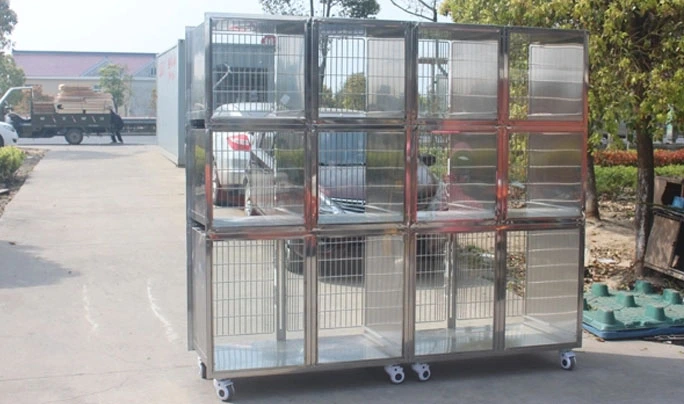Pujia Veterinary Isolation Cages are a specialized type of animal cage designed for medical isolation situations for pets and other animals in veterinary clinics, rescue centers, or animal shelters. These cages have features including negative air pressure ventilation designed to prevent the spread of airborne infections and illnesses between animals. Pujia Veterinary Isolation Cages are made from durable and easy to clean stainless steel and have smooth edges to protect the animal from hurting themselves. They also come in different sizes to accommodate animals of various breeds and species. Pujia Veterinary Isolation Cages provide a safe and secure environment for sick or contagious animals, protecting both the animals and the people involved in their care.
Veterinary isolation cages play a crucial role in preventing the spread of infectious diseases among animals.
Overall, these design innovations have optimized the functionality of veterinary isolation cages, leading to improved animal welfare and better outcomes in veterinary healthcare.

Negative air pressure ventilation: This feature helps prevent airborne pathogens from escaping the enclosure.
HEPA air filtration systems: The HEPA filter helps remove airborne pathogens from the air circulating within the cage.
Access and isolation doors: Veterinary isolation cages, such as the veterinary oxygen cage, have access doors to allow for caregivers to tend to the animal without entering the enclosure.
Durability: The materials used to manufacture veterinary isolation cages are durable and easy to clean, such as stainless steel veterinary cages.
Smooth Edges: The edges of the cage should be smooth to protect the animal from getting injured.
Lighting: The cages may have built-in lighting to allow for better visibility.
Multiple sizes: The cage sizes should accommodate animals of different sizes and species. A dog cage supplier typically offers a variety of sizes to meet these needs.
Access points for food and water: The veterinary isolation cage may include an orifice or access point for food and water.
Removable bottom tray/pan: A removable bottom tray/pan makes it easy to clean the cage.
Access point for cable routing: This feature allows for the transfer of necessary electrical or mechanical equipment, ensuring that the animal is comfortable and can receive adequate medical care.
1. Preventing the spread of infectious diseases: Veterinary isolation cages help limit the spread of infectious diseases, protecting both animals and caregivers.
2. Keep other animals healthy: The use of veterinary isolation cages helps protect other animals in the facility by preventing the spread of contagious diseases.
3. Improved medical management: Veterinary isolation cages help achieve better medical management by allowing a more controlled environment for treating animals.
4. Safety for caregivers: Veterinary isolation cages provide a safe and secure environment for caregivers to tend to animals without the risk of infection from contagious diseases.
5. Provides the best care: The use of veterinary isolation cages ensures that infected animals receive the best possible medical care.
6. Reduces stress on the animal: The veterinary isolation cage provides a safe and secure environment for an infected animal, minimizing its stress levels.
7. Easy to clean: Veterinary isolation cages are made of materials that are easy to clean and disinfected which makes them hygienic and safe to use.
8. Durability: The materials used in veterinary isolation cages are durable and can withstand repeated use.
1. Wear PPE (Personal Protective Equipment) such as gloves, gown, and mask to avoid contact with the animals.
2. Limit contact with the animals and avoid any unnecessary movement inside the enclosure.
3. Ensure that the isolation cage is properly ventilated by running any air filtration systems that may be in place.
4. Follow an appropriate hygiene protocol to limit the risk of transmission between different animals or the caregivers themselves.
5. Always assess the health status of the animal before handling it.
6. Handle the animal gently and calmly to avoid causing any undue stress or discomfort in the animal.
7. Practice good hand hygiene before and after handling the animal.
8. Avoid directly contacting food and water bowls or any other surfaces in the isolation cages without sanitizing or wearing gloves.
9. Follow protocols to dispose of animal waste and cleaning solutions appropriately.
10. Consult the veterinarian or other animal health experts for guidance on how to manage animal care in the veterinary isolation cages.

 What types of animals are typically housed in veterinary isolation cages?
What types of animals are typically housed in veterinary isolation cages?

Any animal with a contagious disease or illness may be housed in an isolation cage, including cats, dogs, small mammals, and birds.

 How are veterinary isolation cages different from regular animal cages?
How are veterinary isolation cages different from regular animal cages?

Isolation cages are typically more enclosed than regular animal cages, with better ventilation and sometimes a separate air filtration system. They often include separate sections for food and waste to minimize exposure to caretakers.

 Are veterinary isolation cages comfortable for animals?
Are veterinary isolation cages comfortable for animals?

Veterinary isolation cages are designed with the animal's comfort and safety in mind. They typically include soft bedding, hiding places, and enrichment items to keep the animal calm and engaged.

 How long can an animal stay in a veterinary isolation cage?
How long can an animal stay in a veterinary isolation cage?

The duration of stay depends on the animal's health and the type of disease. Animals may remain in isolation until they test negative for the infectious agent or until they are deemed safe to reintroduce to the general animal population.




Discover top-quality stainless steel veterinary equipment and inquire for your pet's comfort today!